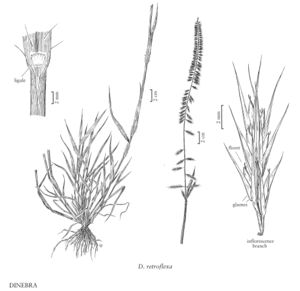Difference between revisions of "Dinebra retroflexa"
FNA>Volume Importer |
FNA>Volume Importer |
(No difference)
| |
Revision as of 19:21, 24 September 2019
Plants loosely tufted. Culms 13-120 cm, decumbent, straggling, often rooting at the lower nodes. Leaves sometimes glandular, particularly on the sheaths; blades 4.5-28 cm long, 4-8 mm wide, finely pointed. Panicles 8-34 cm; branches 0.6-5(7) cm, stiff, initially ascending, reflexed at maturity; disarticulation at the base of the branches. Spikelets 5.7-9 mm, with 1-3 florets. Glumes 5.7-9 mm, asymmetric, coriaceous, keels glandular, apices caudate-curving; lemmas 2.1-2.9 mm, narrowly ovate, appressed pubescent on the lateral veins and adjacent to the lower 1/2 of the central vein; paleas appressed pubescent on the flaps adjacent to the keels. 2n = 20.
Discussion
Dinebra retroflexa is native from southern Africa through tropical Africa to Egypt, Iraq, Pakistan, and India. It has reportedly been found on chrome ore piles in Canton, Maryland, a temporary unloading ground for ores in the Port of Baltimore (Reed 1964), and in Mecklenberg County, North Carolina. It is a common weed of rich soils in moist, tropical regions.
Selected References
None.
